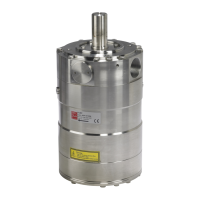Instruction APP pump instruction APP (W) 5.1-10.2
2
180R9072 / 521B0747 / DKCFN.PI.010.D5.02 / 11.2014
1. Identication
2. System design
Nessie® is a trademark of Danfoss A/S
521B0747 DKCFN.PI.010.D4.ML
type APP 5.1/5.6/7.2/8.2/10.2
4. Mise en route initiale
3. Montaje de la unidad de bombeo
2.1 Systèmes ouverts avec réservoir d’eau
2.2 Systèmes ouverts avec alimentation directe
La conception du système doit garantir que la pompe ne puisse se vider
lorsque l’installation est à l’arrêt
La pression à l’entrée de la pompe ne peut jamais excéder la pression
à la sortie. Ceci peut survenir lorsque la pompe est alimentée par une
pompe de gavage ou dans des systèmes ouverts avec alimentation
Afi n d’éviter tout problème, il est recommandé d’installer un clapet
anti-retour pré-taré en sortie de pompe ou un pressostat à l’entrée de la
La pression d’ouverture du clapet anti-retour doit être supérieure ou
égale à la pression mesurée à l’entrée de la pompe.
Los sistemas pueden ser de dos tipos:
2.1. Sistema abierto a presión atmosférica con suministro de agua de un
2.2. Sistema abierto a presión atmosférica con suministro directo de
2.3. Problemas con bombas reversibles
El diseño del sistema debe asegurar que la bomba de agua no se vacíe
La presión de la entrada de agua a la bomba nunca debe de ser superior
a la presión de salida. Esto puede ocurrir normalmente en sistemas con
una bomba booster o en sistemas abiertos a presión atmosférica con
un suministro directo de agua. Para evitar esto, se recomienda instalar
una válvula antiretorno pretensionada o una válvula de seguridad
entre la bomba y la válvula bypass. La presión de apertura de la válvula
antiretorno debe ser mayor o igual a la presión de entrada del agua.
3. Building up the pump unit
3. Aufbau der Pumpeneinheit
2.1 Open-ended systems with water supply from a tank.
2.2 Open-ended systems with direct water supply.
2.3 Problems with reversing pumps
The design of the system must ensure that self-emptying of the pump
during standstill is avoided.
The inlet pressure of the pump must never exceed the outlet pressure.
This may typically occur in boosted or open-ended systems with direct
In order to avoid this, it is recommended to install a prestressed check
valve or a pressure switch in the pump inlet.
The opening pressure of the check valve must be bigger or equal to the
2.1 Off ene Systeme ohne Rückführung mit Versorgung aus einem Tank.
2.2 Off ene Systeme ohne Rückführung, mit direkter Wasserversorgung.
Der Systemaufbau muß sichern, daß sich die Pumpe im Stillstand nicht
Der Druck am Pumpeneinlaß darf den Druck am Pumpenauslaß nicht
übersteigen. Dies mag typisch in “boosted” oder off enen Systemen mit
direkter Wasserversorgung auftreten.
Um dies zu vermeiden, empfehlen wir die Montage eines vorgespann-
ten Rückschlagventils oder eines Druckschalters in der Pumpeneinlass-
Seite. Der Öff nungsdruck des Rückschlagventils muß den Einlaßdruck
übersteigen oder diesem gleich sein.
The design of the system must ensure that
self-emptying of the pump during standstill is
avoided.
The inlet pressure of the pump must never
exceed the outlet pressure. This may typically
occur in boosted or open-ended systems with
direct water supply.
In order to avoid this, it is recommended to
install a prestressed check valve or a pressure
switch in the pump inlet.
The opening pressure of the check valve must be
bigger or equal to the inlet pressure.
1. Identication ...........................................................................2
2. System design ..........................................................................2
2.1 Open-ended systems with water supply from tank.......................................3
2.2 Open-ended systems with direct water supply...........................................3
2.3 Reversible pumps .......................................................................3
2.4 General guidelines for calculation of pressure losses .....................................4
2.5 General comments on...................................................................4
3. Building up the pump unit ..............................................................5
3.1 Mounting ...............................................................................5
3.2 Direction of rotation ....................................................................5
3.3 Orientation .............................................................................5
3.4 Protection from too high pressures ......................................................6
3.5 Connections ............................................................................6
4. Initial start-up...........................................................................7
5. Operation...............................................................................7
5.1 Temperature ............................................................................7
5.2 Pressure ................................................................................7
5.3 Dry running.............................................................................7
5.4 Disconnection ..........................................................................7
5.5 Storage .................................................................................7
5.5.1 Open-ended systems with water supply from tank.......................................7
5.5.2 Open-ended systems with direct water supply...........................................8
6. Service..................................................................................8
6.1 Periodic maintenance . . . . . . . . . . . . . . . . . . . . . . . . . . . . . . . . . . . . . . . . . . . . . . . . . . . . . . . . . . . . . . . . . . .8
6.2 Repair ..................................................................................8
7. EC Declaration of Conformity............................................................9
Table of Contents

